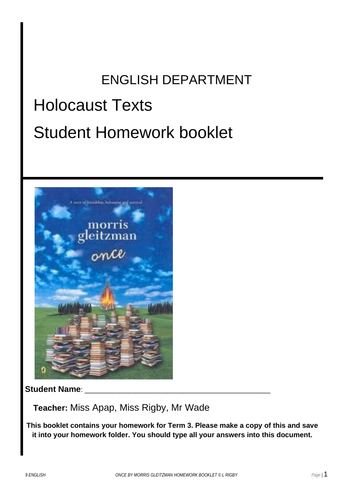


Includes 6 weeks worth of homework activities including chapter questions, a vocabulary list (and activities) and tips for creative writing.
It steps students through an assessment task which requires students to write a short story (a transformation of a section of the novel and a preface justifying their creative decisions). Specific task details are below.
Mode/Medium: Imaginative Written short story (fiction).
Subject Matter: Throughout time short stories have captured the imaginations of both readers and listeners. A good short story will capture the interest of its audience and hold it to the end.
Purpose: To entertain and demonstrate your knowledge of the short story genre.
Task: For this task you have a choice:
1. Write an imaginative short story that creates a character or “gives voice” to a silenced or marginalised character in the novel that you have studied in class.
2. Place the character into the novel which you have studied in class. This can be at the beginning, the middle or end of a scene. For example, you might write from the perspective of someone who observed an event, assisted the protagonist or befriended them. Or you may create a new character. E.g. A new best friend for the protagonist.
Your teacher will explain what it means to “give voice” to a character in a novel. Your character must interact with the novel’s protagonist. You may change the storyline and plot to accommodate your character if you desire, however, your story must remain true to the themes and setting of the novel. (E.g. you can’t turn it into a comedy or change the country where the novel is set).
Requirements: Length is to be 400-500 words plus a 100 word preface explaining how the story is both original and imaginative.
You must demonstrate that you have a sound knowledge of short story conventions and adhere to the short story structure. You can make your story both original and imaginative in the following ways:
• Creative use of the conventions of a short story, for example a twist at the end.
• Create non-stereotyped characters that make unpredictable choices.
• Juxtapose related texts.
• Promote alternative beliefs and values through your writing.
Something went wrong, please try again later.
This resource hasn't been reviewed yet
To ensure quality for our reviews, only customers who have purchased this resource can review it
Report this resourceto let us know if it violates our terms and conditions.
Our customer service team will review your report and will be in touch.
